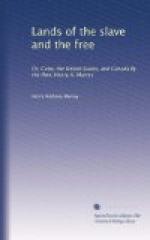in number—most decidedly lit upon our legs,
and the cuisine and the cellar lent effectual aid.
The proprietor is an elderly man, and the son, who
has travelled a good deal in Europe, manages the properties,
which consist of several plantations, and employ about
twelve hundred slaves. The sound of the lash
is rarely heard, and the negroes are all healthy and
happy-looking; several of them have means to purchase
their liberty, but prefer their present lot.
A doctor is kept on the estate for them; their houses
are clean and decent; there is an airy hospital for
them if sick, and there is a large nursery, with three
old women who are appointed to take charge during
the day of all children too young to work: at
night they go to their respective families. On
the whole property there was only one man under punishment,
and he was placed to work in chains for having fired
one of his master’s buildings, which he was supposed
to have been led to do, owing to his master refusing
to allow him to take his infant home to his new wife
till it was weaned; his former wife had died in child-bed,
and he wished to rear it on arrowroot, &c. This
the master—having found a good wet nurse
for it—would not permit. The man had
generally borne a very good character, and the master,
whose
entourage bears strong testimony to his
kind rule, seized the opportunity of my visit to let
him free at my request, as he had already been working
four months in chains similar to those convicts sometimes
wear; thus were three parties gratified by this act
of grace.
It is well known that there are various ways of making
sugar; but as the method adopted on this plantation
contains all the newest improvements, I may as well
give a short detail of the process as I witnessed it.
The cane when brought from the field is placed between
two heavy rollers, worked by steam, and the juice
falls into a conductor below—the squashed
cane being carried away to dry for fuel—whence
it is raised by what is termed a “monte jus”
into a tank above the “clarifier,” which
is a copper boiler, with iron jacket and steam between.
A proper proportion of lime is introduced, sufficient
to neutralize the acidity. When brought to the
boiling-point the steam is shut off, and the liquid
subsides. This operation is one of the most important
in the whole process; from the clarifier it is run
through an animal charcoal filterer, which, by its
chemical properties, purifies it; from the filterer
it runs into a tank, whence it is pumped up above the
condensers, i.e., tubes, about fifteen in number,
laid horizontally, one above the other, and containing
the steam from the vacuum pans. The cold juice
in falling over these hot tubes, condenses the steam-therein,
and at the same time evaporates the water, which is
always a considerable ingredient in the juice of the
cane; the liquor then passes into a vacuum pan, which
is fitted with a bull’s-eye on one side, and
a corresponding bull’s-eye with a lamp on the




